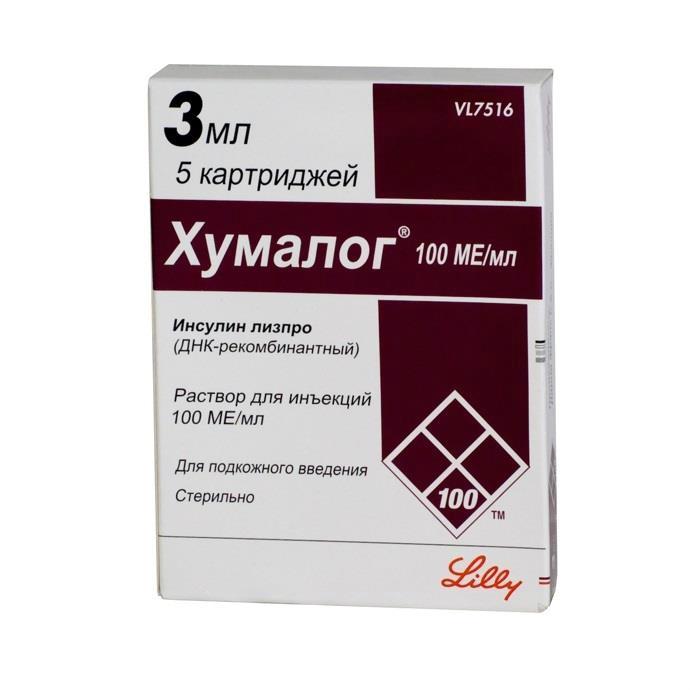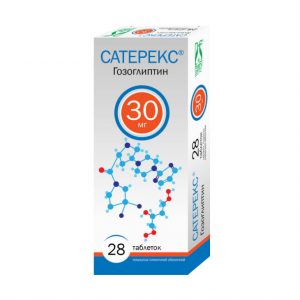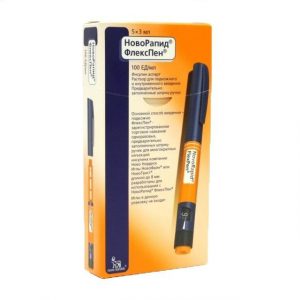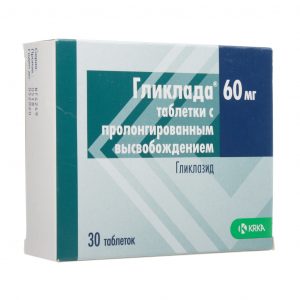Description
Latin name
HUMALOG
Packaging
5 cartridges of 3 ml.
Pharmacological action
Humalog – DNA recombinant human insulin analogue. It differs from the latter by the reverse sequence of amino acids at positions 28 and 29 of the insulin B chain.
The main effect of the drug is the regulation of glucose metabolism. In addition, it has an anabolic effect. In muscle tissue, there is an increase in the content of glycogen, fatty acids, glycerol, an increase in protein synthesis and an increase in the consumption of amino acids, but there is a decrease in glycogenolysis, gluconeogenesis, ketogenesis, lipolysis, protein catabolism and the release of amino acids.
In patients with type 1 and type 2 diabetes mellitus, the use of lyspro insulin reduces the hyperglycemia that occurs after eating more significantly than soluble human insulin. For patients receiving short-acting and basal insulins, it is necessary to select a dose of both insulins in order to achieve optimal blood glucose levels throughout the day.
As with all insulin preparations, the duration of lyspro insulin action can vary in different patients or at different time periods in the same patient and depends on the dose, injection site, blood supply, body temperature and physical activity.
The pharmacodynamic characteristics of lispro insulin in children and adolescents are similar to those observed in adults.
In patients with type 2 diabetes receiving maximum doses of sulfonylurea derivatives, the addition of insulin lispro leads to a significant reduction in glycated hemoglobin.
Lyspro insulin treatment for patients with type 1 and type 2 diabetes is accompanied by a decrease in the number of episodes of nocturnal hypoglycemia.
The glucodynamic response to lispro isulin is independent of renal or hepatic impairment.
Lyspro insulin has been shown to be equimolar to human insulin, but its effect is more rapid and lasts for a shorter time.
Lyspro insulin is characterized by a rapid onset of action (about 15 minutes), because It has a high absorption rate, and this allows you to enter it immediately before meals (0-15 minutes before meals), unlike regular short-acting insulin (30-45 minutes before meals). Lyspro insulin has a shorter duration of action (2 to 5 hours) compared to conventional human insulin.
Pharmacokinetics
Absorption and distribution of
After subcutaneous administration, lispro insulin is rapidly absorbed and reaches Cmax in the blood plasma after 30-70 minutes. Vd of insulin lyspro and ordinary human insulin are identical and are in the range of 0.26-0.36 l / kg.
Excretion of
With subcutaneous administration of T1 / 2 insulin, lispro is about 1 hour. In patients with renal and hepatic insufficiency, a higher rate of absorption of lyspro insulin remains compared to conventional human insulin.
Indications
Diabetes mellitus in adults and children, requiring insulin therapy to maintain normal glucose levels.
Contraindications
Hypoglycemia hypersensitivity to the components of the drug.
Use during pregnancy and lactation
To date, no adverse effects of insulin lispro on pregnancy or the health of the fetus / newborn have been identified. No relevant epidemiological studies have been conducted.
The goal of insulin therapy during pregnancy is to maintain adequate glucose control in patients with insulin-dependent diabetes mellitus or with gestational diabetes. The need for insulin usually decreases in the first trimester and increases in the second and third trimesters of pregnancy. During and immediately after birth, insulin requirements may decrease dramatically.
Women of childbearing age with diabetes should inform their doctor about a new or planned pregnancy. During pregnancy, patients with diabetes require careful monitoring of blood glucose levels, as well as general clinical monitoring.
In patients with diabetes mellitus during breastfeeding, dosage adjustment of insulin and / or diet may be required.
Composition of
1 ml of solution for intravenous and subcutaneous administration contains: active ingredient: insulin lispro 100 IU,
excipients: glycerol (glycerin) – 16 mg, metacresol – 3.15 mg, zinc oxide (qs for Zn2 + 0.0197 μg), sodium hydrogen phosphate heptahydrate – 1.88 mg, hydrochloric acid solution 10% and / or sodium hydroxide solution 10% – qs to pH 7.0-8.0, water for injection – qs up to 1 ml.
Dosage and administration depending on the patient, the doctor determines the dose. Humalogue can be administered shortly before a meal, if necessary, immediately after a meal.
The temperature of the administered drug should be at room temperature.
Humalog is administered subcutaneously as an injection or as an extended subcutaneous infusion using an insulin pump. If necessary (ketoacidosis, acute illness, the period between operations or the postoperative period) Humalog can be administered intravenously.
Subcutaneously should be injected into the shoulder, thigh, buttock or abdomen. The injection sites should be alternated so that the same place is used no more than 1 time per month. With subcutaneous administration of the Humalog drug, caution must be exercised to avoid getting the drug into a blood vessel. After the injection, the injection site should not be massaged. The patient should be trained in the correct injection technique.
Rules for the administration of the drug Humalog
Preparation for the administration of
The solution of the drug Humalog should be transparent and colorless. A cloudy, thickened or slightly colored solution of the drug, or if solid particles are visually detected in it, should not be used.
When installing the cartridge in the syringe pen (pen-injector), attaching the needle and injecting insulin, follow the manufacturer’s instructions that are included with each syringe pen.
Introduction
Wash hands.
Select a site for injection.
Apply antiseptic to the skin at the injection site.
Remove the cap from the needle.
Fix the skin by stretching it or by snapping a large fold. Insert the needle in accordance with the instructions for using the syringe pen.
Click the button.
Remove the needle and gently press the injection site for a few seconds. Do not rub the injection site.
Using the needle cap, unscrew the needle and destroy it.
The injection site should be alternated so that the same place is used no more than about 1 time per month.
Intravenous administration of insulin
Intravenous injection of Humalog should be carried out in accordance with the usual clinical practice of intravenous injection, for example, intravenous bolus administration or using an infusion system. In this case, it is often necessary to control the level of glucose in the blood.
Infusion systems with concentrations from 0.1 IU / ml to 1.0 IU / ml insulin lispro in 0.9% sodium chloride solution or 5% dextrose solution are stable at room temperature for 48 hours.
Subcutaneous insulin infusion with an insulin pump
For infusion of Humalog, Minimed and Disetronic pumps can be used to infuse insulin. You must strictly follow the instructions that came with the pump. The infusion system is changed every 48 hours. When connecting the system for infusion, observe aseptic rules. In the event of a hypoglycemic episode, the infusion is stopped until the episode resolves. If there are repeated or very low levels of glucose in the blood, then you must inform your doctor about this and consider reducing or stopping the insulin infusion. A pump malfunction or a blockage in the infusion system can lead to a rapid rise in glucose levels. In case of suspicion of a violation of the supply of insulin, you must follow the instructions and, if necessary, inform the doctor. When using a pump, Humalog should not be mixed with other insulins.
Side effects
Side effect associated with the main effect of the drug: hypoglycemia. Severe hypoglycemia can lead to loss of consciousness (hypoglycemic coma) and, in exceptional cases, to death.
Allergic reactions: local allergic reactions are possible – redness, swelling or itching at the injection site (usually disappear within a few days or weeks) systemic allergic reactions (occur less often, but are more serious) – generalized itching, urticaria, angioedema, fever, shortness of breath, decreased blood pressure, tachycardia, increased sweating. Severe cases of systemic allergic reactions can be life threatening.
Local reactions: lipodystrophy at the injection site.
Drug Interactions
Hypoglycemic action of Humalog is reduced by oral contraceptives, ACS, thyroid hormone preparations, danazol, beta2-adrenomimetics (including ritodrine, salbutamol, terbutalin) tricyclic antidepressants, thiazide diuretics, chlorprothixene, diazoxide, isoniazid, lithium carbonate, nicotinic acid, phenothiazine derivatives. srlk srlk glygicemic Beta-blockers, ethanol and ethanol-containing drugs angiotensin II receptor antagonists.
Humalog should not be mixed with animal insulin preparations.
Humalog can be used (under the supervision of a doctor) in combination with longer-acting human insulin or in combination with oral hypoglycemic agents, sulfonylureas.
Overdose
Symptoms: hypoglycaemia, accompanied by the following symptoms: lethargy, sweating, tachycardia, headache, vomiting, confusion.
Treatment: Mild conditions of hypoglycemia are usually stopped with glucose or other sugar intake, or sugar-containing products.
Correction of moderately severe hypoglycemia can be accomplished by intramuscular or subcutaneous administration of glucagon followed by carbohydrate intake after stabilization of the patient’s condition. Patients who do not respond to glucagon are given intravenous dextrose (glucose).
If the patient is comatose, glucagon should be given intramuscularly or subcutaneously. In the absence of glucagon or if there is no reaction to its administration, dextrose (glucose) solution should be administered intravenously. Immediately after regaining consciousness, the patient should be given carbohydrate-rich foods.
Further supportive carbohydrate intake and patient monitoring may be required as well. hypoglycemia recurrence may occur.
Storage conditions
2 years. The product in use should be stored at room temperature from 15 ° to 25 ° C and protected from direct sunlight and heat. Shelf life – no more than 28 days.
Expiration
2 Year
Deystvuyuschee substances
Insulin lyzpro
dosage form srdlfrd srdklrd 25rd




